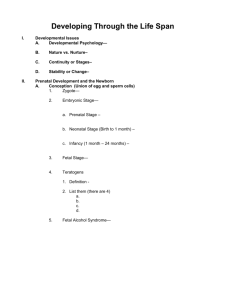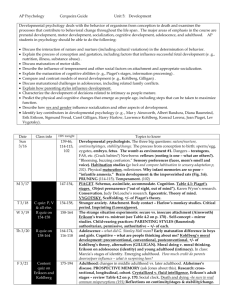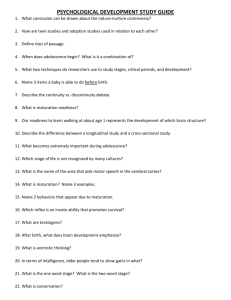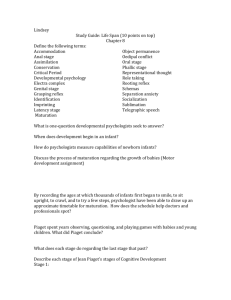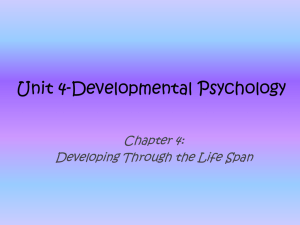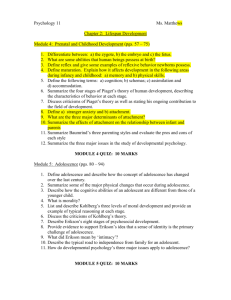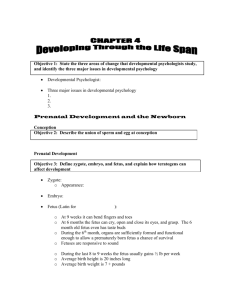Chapter 3 - DeForest Area School District
advertisement
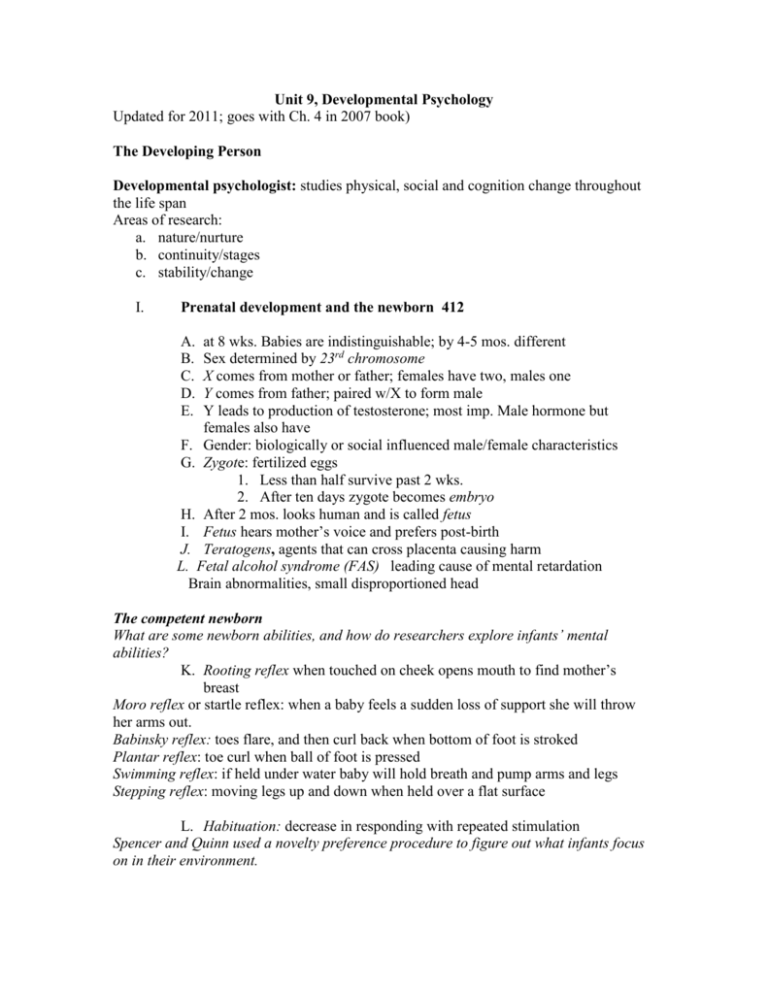
Unit 9, Developmental Psychology Updated for 2011; goes with Ch. 4 in 2007 book) The Developing Person Developmental psychologist: studies physical, social and cognition change throughout the life span Areas of research: a. nature/nurture b. continuity/stages c. stability/change I. Prenatal development and the newborn 412 A. B. C. D. E. at 8 wks. Babies are indistinguishable; by 4-5 mos. different Sex determined by 23rd chromosome X comes from mother or father; females have two, males one Y comes from father; paired w/X to form male Y leads to production of testosterone; most imp. Male hormone but females also have F. Gender: biologically or social influenced male/female characteristics G. Zygote: fertilized eggs 1. Less than half survive past 2 wks. 2. After ten days zygote becomes embryo H. After 2 mos. looks human and is called fetus I. Fetus hears mother’s voice and prefers post-birth J. Teratogens, agents that can cross placenta causing harm L. Fetal alcohol syndrome (FAS) leading cause of mental retardation Brain abnormalities, small disproportioned head The competent newborn What are some newborn abilities, and how do researchers explore infants’ mental abilities? K. Rooting reflex when touched on cheek opens mouth to find mother’s breast Moro reflex or startle reflex: when a baby feels a sudden loss of support she will throw her arms out. Babinsky reflex: toes flare, and then curl back when bottom of foot is stroked Plantar reflex: toe curl when ball of foot is pressed Swimming reflex: if held under water baby will hold breath and pump arms and legs Stepping reflex: moving legs up and down when held over a flat surface L. Habituation: decrease in responding with repeated stimulation Spencer and Quinn used a novelty preference procedure to figure out what infants focus on in their environment. II. Infancy and Childhood 415 Physical development During infancy and childhood, how do the brain and motor skills develop? Brain development A. Maturation biological processes that promote development The association areas of the brain are the last to develop. B. Rosenzweig and Krech found that rats develop thicker cortex in playground environment v. those in isolation. C. For optimal development early years are critical Motor development develops in a predictable sequence with genes playing a major role Maturation and infant memory 417 “Infantile amnesia” lack of memories before three due to neurons being immature; experience helps develop better memory Cognitive development From the perspective of Jean Piaget and today’s researchers, how does a child’s mind develop? Piaget interested in children’s wrong answer; he is to cognitive development understanding as Copernicus is to solar system understanding. D. Plasticity the brain can reorganize pathways where there’s damage or adjacent neurons can compensate Child’s brain, more plasticity due to excess neurons Experience influences motor behavior: more neurons connect III. Cognitive Development, 147 A. Cognition processes for thinking, remembering and knowing B. Jean Piaget’s Stage Theory (see table 9.1 p. 420) His research is based on what is considered one of the 40 greatest experiments of all time Key terms 1. Schemas a framework helping us to organize information 2. Assimilation interpreting new info in terms of existing schemas ex. all four legged creatures are doggies to a small child who knows dogs 3. Accommodation adapting your schemas to fit new info Ex. child realizes not all four legged creatures are dogs C. Stages 1. Sensorimotor Birth - age 2 Understand world through senses/motor activities Lack object permanence until around 1: when baby realizes objects exist even when hidden Today’s researchers view development as more continuous than Piaget did. He underestimated children’s competence. 2. Pre-Operational ages 2 to 6/7 Language development Lacks concrete thinking Lacks conservation: that a change in size doesn’t change quantity; volume, length and area conservation errors are made. Egocentrism: unable to see other’s point of view Symbolic thinking occurs earlier than Piaget thought possible as shown in Judy DeLoache’s experiment with 2 and 3 year olds using Snoopy dolls in a miniature setting and a real room. Theory of mind (David Premack and Gary Woodruff) 422 Preschoolers develop ability to infer about others’ mental states Ability to tease, empathize and persuade follows Between 5 and 8 learn that a thought can produce feeling Autism and Mind Blindness Close up: pp. 424-425 Child is deficient in communication and social interaction skills Have difficulty understand others’ states of mind. Speech difficulty Clumsiness Fibers that connect various brain regions are altered Autism spectrum disorder Asperger’s syndrome: high functioning autism Simon Baron Cohen says that autism represents an extreme male brain: far less empathy and much more rule based. Brain studies indicate those with autism have much less activity in areas of the brain with high concentration of mirror neurons. By 7, children think in words; Lev Vygotsky said they do this by relying on inner speech, no longer thinking outloud, 3. Concrete Operational Stage 6/7 to 11 423 Child understands concrete operations and mathematical transformations (reversing mathematical operations) Logical thinking 4. Formal Operational 12 and up 423 Reasoning expands to abstract thinking Able to solve problems to hypothetical situations Assessment of Piaget 423 1. Cognition unfolds in the sequence Piaget suggests 2. Younger children more capable than he believed 3. Development is more continuous than he thought IV. Social Development, 426 How do parent-infant attachments form? A. Children develop attachments to those who care for them B. Prefer familiar faces/voices C. After object permanence child develops stranger anxiety: fear of strangers after 8 mos. D. Origins of Attachment: emotional tie with caregiver Body contact E. Harry Harlow’s monkey studies: considered one of the 40 greatest psychology experiments of all time He created two artificial mothers for infant monkeys. It was thought the mother with the nourishment would occupy most of the monkey’s attention. Not so. 1. Monkeys preferred the cloth mother over the wire mesh mother with milk Harlow (1971) concluded body contact is more important than nourishment to attachment Familiarity F. Critical period: optimal period after birth when exposure to things to leads to proper development G. Humans don’t have a critical period H. Imprinting: certain animals form attachments after birth Konrad Lorenz (1937) studied imprinting of ducklings Children do not imprint but they do have a sensitive period during which mere exposure to people and things fosters fondness. I. Attachment differences: Temperament and Parenting 427 How have psychologists studied attachment differences, and what have they learned about the effects of temperament and parenting? 1. Mary Ainsworth studies (1979) 2. Attachment: seeking closeness with caregiver 3. Secure attachment: 60 percent of infants display this toward their caregiver. Results from parents who are Trustworthy, Dependable and Responsive 4. Ainsworth’s strange situation: at one year child is put in one and indicates their emotional health based on how secure their attachment is with their mother 5. Sensitive, responsive mothers have infants who are securely attached Temperament: characteristic emotional reactivity and intensity 1. Some babies are born relaxed/cheerful, while others born tense/irritable 2. Identical twins will have more similar temperaments than non-identical 6. Erik Erikson: securely attached children approach life with a basic trust: the world is predictable and trustworthy 7. Most abusive parents have been neglected and battered as children 8. Deprivation of attachment 430 Causes withdrawal and fear Harlow’s monkeys were socially scarred after being reared by artificial mothers. Most children who grow up under adversity are resilient. 9. Most abusers were abused, but most abused children do not later become violent or abusive parents 10. Childhood trauma does leave “footprints” on the brain in the form of fewer new brain neurons later in life 11. Disruption of attachment 431 John Bowlby studies (1973): separation from family can lead to being upset, withdrawn and despair. Does day care affect attachment? Those in day care had slightly advanced thinking and language skills Family poverty consigns children to poor quality day care Quality day care does not harm secure attachment Self-Concept 432 How do children’s self-concepts develop, and how are children’s traits related to parenting styles? By age 12 most children develop their self-concept, their sense of worth and identity; positive self-concepts produce optimism, confidence and independence Self-concept sense of identity and personal worth Self-awareness begins when we recognize our self in a mirror: Rouge Test, noticed around 15-18 months. Other species recognize their self as well. Parenting Styles 433 Child rearing practices 1. Authoritarian parents impose rules and expect obedience 2. Authoritative parents demanding yet responsive; open communication allowing exceptions 3. Permissive parents submit to children’s desires making few demands 4. Rejecting neglecting parents disengaged, expecting and getting little 5. Diane Baumrind’s studies (1996): Authoritative parenting leads to high self esteem and confidence and self reliance, greatest sense of self control and highest motivation Culture and Child-Rearing 434 Asians and Africans have a strong sense of family self. Their collectivist cultures value family over the individual. European cultures value individual goals and pride. Gender Development 435 Gender: the biological and social characteristics by which we define male and female. Gender similarities and differences What are some ways in which males and females tend to be alike and to differ? 1. Gender and aggression. There is a gender gap in physical but not relational aggression. 2. Gender and social power. Men are seen as more dominant and independent; women seen as more democratic and supportive. Most legislators are men and women are underpaid compared to men. 3. Gender and social connectedness. Carol Gilligan believes women are more concerned with making connections (1982). Women are more interdependent and when facing stress practice “tend and befriend”. The nature of gender 437 How do nature and nurture together form our gender? 1. Mother (egg) contributes the X chromosome 2. The father’s (sperm) chromosome (X or Y) determines the baby’s sex A female embryo exposed to too much testosterone leads to a female who: Acts more aggressive and, Acts more tomboyish … will be treated more like a boy The nurture of gender 439 Gender roles 1. Role: cluster of prescribed actions When we don’t follow roles we can feel anxiety because of normative social influence acting on us: we’re not doing what we’re supposed to do. 2. Gender role: expectations for how males/females should act Gender and Child-Bearing 440 3. Gender identity: one’s sense of being male or female 4. Gender-typing: acquisition of a traditional masculine or feminine 5. Social learning theory You learn your behavior by observing and imitating the behavior of a model And then being rewarded or punished when you display that behavior 6. Gender schema theory Children learn more from their cultures a concept of what a male or female is and adjust their behavior to those observations Your culture teaches you what it means to be male/female and, you behave in that way. Androgyny: •Sandra Bem •Blend of masculinity and femininity results in greater behavioral adaptiveness •Androgynous people have a balance of masculine and feminine characteristics Peers and Parents 441 To what extent is development shaped by early stimulation, by parents and by peers? A. Parental influence Influence on children is less than popular psychology assumes 3. Prenatal environment Those who develop with separate placentas are somewhat less similar in their psychological traits B. Experience and the brain 1. Repeated learning experiences help develop neural connections 2. Mark Rosezweig and David Krech (1984, 1987) showed how rats living in an enriched enviro had a thicker and heavier brain cortex 3. The Mozart Effect was one failed attempt to improve cognitive development by exposing infants to classical music. 4. Tiffany Field found that “handled” infant rats and premature babies developed faster neurologically and gained more weight (2007). How much credit or blame do parents deserve? Parents matter but on personality measures children from the same family share few characteristics. C. Peer influence 1. smoking, cooperation, becoming popular all influenced by peers 2. Judith Harris: children get their culture from their peers (1998, 2007) 3. Howard Gardner: parents and peers are complementary (1998). V. Adolescence 445 What physical changes mark adolescence? Transition from childhood to adulthood A. Sexual maturity is occurring earlier due to nutrition 1. Begins with puberty, girls at 11, boys at 13 2. Early maturation is good for boys 3. Early maturation is stressful for girls B. Primary sex characteristics 1. Reproductive organs C. Secondary sex char. 1. Girls breasts, hips 2. Boys facial hair, voice D. Landmarks 1. Boys, ejaculation (first one usually as a nocturnal emission—spermarche). Girls, Menarche (the beginning of menstruation) E. Personality is modified during adolescence Frontal lobe development lags behind emotional development; this and hormonal surge explains: Impulsiveness Risky behaviors Emotional storms Teen brains aren’t fully capable of making long range planning or curbing impulses F. Reasoning is self-focused: “ no one understands me” Cognitive development 448 How did Piaget, Kohlberg and later researchers describe adolescent cognitive and moral development? For Piaget this was formal operational thinking. VI. Developing Morality Lawrence Kohlberg built on the thinking of Piaget His research is considered one of the 40 greatest psychology experiments of all time (1981, 1984). He gave young boys a moral dilemma (Heinz’s wife was dying and he couldn’t afford the lifesaving medicine) and had them reason it out to his research assistants. A. Pre conventional Morality to age 9 You obey to avoid punishment or gain rewards B. Conventional Morality by early adolescence You follow actions that gain social approval or maintain order You obey because it is the law C. Post conventional Morality You follow what affirms people’s rights or ethical considerations based on Your own perceptions Attained by those with abstract reasoning and formal operations Critics charged that those from Western cultures reason differently from Asian cultures Moral feeling Jonathan Haidt’s social intuitionist account of morality Feelings come before reasoning; therefore we can make some moral judgments rather quickly without thinking Moral action Service learning programs improve school attendance and lower dropout rates. Those who learn to delay gratification become more responsible and have better academic outcomes. D. Criticisms of Kohlberg’s theory 1. Moral behavior is also influenced by the social situation and attitudes 2. Mostly studied males Carol Gilligan (Colleague of Kohlberg) Emphasized the study of female moral reasoning and found differences with males Females have a care orientation and males have a justice orientation 3. Only studied individual decision-making (cultural bias for individualism) VI. Social Development 450 What are the social tasks and challenges of adolescence? Identity one’s sense of self Social identity a distinctive connection to a group of which you feel a part. A. James Marcia’s Identity statuses The presence or absence of crisis or commitment combines to form these: 1. Foreclosure premature commitment to visions, values and roles (you have an identity, but it was given to you; later you’ll develop your own) 2. Moratorium delaying commitment to experiment with alternative ideologies 3. Identity diffusion rudderless apathy 4. Identity achievement achieving a sense of self after considering alternatives B. Erik Erikson’s Psychosocial stages see table 9.2, p. 451 At each stage in life we face a crisis we must resolve 1. Infancy Trust v. Mistrust (“Mommy!”) 2. Toddlerhood Autonomy v. Shame (“No!” or “Terrible twos”) 3. Preschooler Initiative v. Guilt (“Mommy watch me”) 4. Elementary school competence v. inferiority (“Plays well with others”) 5. Adolescence Identity v. role confusion (“Who am I?”) Girls: formed in small groups, more social, more open Boys: formed in large groups, more competitive 6. Young adult intimacy v. isolation (“Do you love me?”) Intimacy: the ability to form emotionally close relationships 7. Middle adult generativity v. stagnation (“I just want to give something back”) 8. Late adult integrity v. despair (“It’s been a good life”) Parent and Peer Relationships Parents influence religion, work and politics; peers influence social and cultural behaviors. VIII. Emerging Adulthood 453 What is emerging adulthood? We are maturing earlier, but emerging into adulthood later: 18 to mid-20s. Adulthood 455 Physical Development What physical changes occur during middle and late adulthood? A. Physical abilities peak in early adulthood B. Women mature earlier than men C. Menopause end of menstruation Doesn’t necessarily cause emotional problems for women: expectations are the key D. Men: declining sperm count, testosterone level, speed of erection and ejaculation Physical changes later in life 457 Gradual loss of brain cells, can be compensated for by keeping mentally active More vulnerable to short term illness Recognition memory declines Life satisfaction declines after 65 (peaking in the 50s) Life expectancy Higher for females Birth sex ratio is 105 males to 100 females Sensory abilities These decline. Health Immunes system weakens Neural functioning slows F. Dementia and Alzheimer’s 460 Progressive, irreversible brain disorder; 3% get by 75 Characterized by memory loss, reasoning and brain functions Acetylcholine loss due to affected neurons Cognitive Development 461 How do memory and intelligence change with age? Meaningless information is less easily remembered Recognition is better than recall Prospective memory: remember to type of events are easier to remember when triggered by some activity; but habitual tasks are easily forgotten Retrospective memory refers to remembering information from the past. It is the complement to prospective memory (which refers to remembering to do something in the future). All types of memory other than prospective memory may be deemed to be "retrospective" memory. Aging and intelligence 462 Phase II: Longitudinal evidence for intellectual stability 463 Longitudinal study Same ages studied over time Werner Schaie found that intelligence maintained and even increase in some areas (1982). Phase I: Cross-sectional evidence for intellectual decline 463 Cross sectional study Differing ages observed over time David Wechsler identified a decline (1972). Phase III: It all depends (on how you measure it) Crystallized intelligence 1. Maintains as you age 2. Verbal skills and accumulated knowledge Fluid intelligence 1. Declines with age; slowly up to 75, then more rapidly 2. Reasoning quickly and abstractly Social Development 465 Adulthood’s Ages and Stages Midlife transition is a crisis? This has no research support. Social clock: the right time to be: leaving home, getting a job, marrying, having kids, retiring. Varies from culture to culture and era to era. Chance encounters: Determine the roads we take Can affect whom we marry Romantic love based on imprinting: you bond with anyone who has similar background and level of attraction who reciprocates Adulthood’s commitments 466 Dominated by intimacy and generativity (Erikson), or as Freud would orient it, love and work. Marriage predicts happiness, health, sexual satisfaction and income Successful marriages have five times more positive interactions than negative ones, according to John Gottman’s research (1994). Empty nest: reported feelings of happiness when children leave home “Post launch honeymoon” if they maintain good relations with children Age doesn’t affect satisfaction and happiness with life Work Quality of experience matters Interest, competence and accomplishment are key to successful work life Well being across the life span 468 Positive feelings grow after midlife, while negative ones subside. The amygdala responds less to negative events. With age the emotional roller coaster becomes a canoe paddled down a river. The biopsychosocial influences on aging include: optimism, social support, meaningful activities, good nutrition and no genes predisposing dementia or other diseases. IX. Death and Dying 470 Grief is more severe when death is unexpected or before one’s time There is no normal reaction, despite the following theory: Elisabeth Kubler Ross A. Terminally ill pass thru 5 stages (dabda) 1. Denial unacceptance of illness 2. Anger ask, Why me? 3. Bargaining with God 4. Depression loss of everything and everyone 5. Acceptance peaceful, accepting one’s fate No longer much evidence for this theory (Nolen-Hoeksema and Larson, 1999) Erik Erikson: integrity results when life has been meaningful and worthwhile. Reflections on the major issues 471 Stages are useful to conceptualize though we don’t travel neatly through them. Are personalities consistent over time? Yes and no. First two years are poor indicators. Temperament is more stable than social attitudes. We all change: more shy become less; conscientiousness increases in 20s; agreeableness in the 30s Key terms: 476 (See study guide) AP Quiz: 476-477

